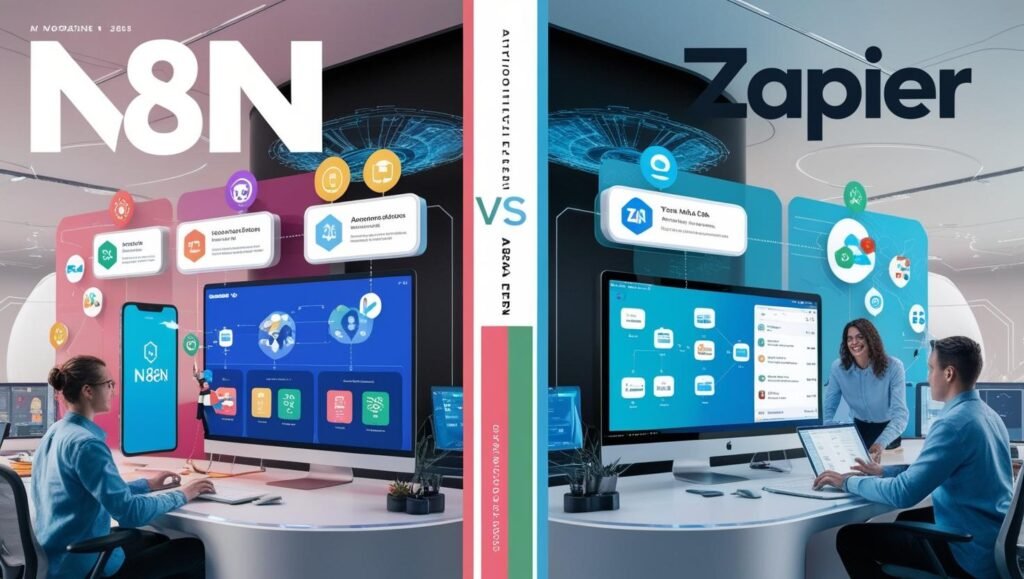Understanding n8n vs Zapier: A No-Code Automation Overview
When it comes to no-code automation platforms, both n8n and Zapier offer powerful solutions tailored for different user needs, empowering professionals to streamline their workflows without the need for extensive programming knowledge.
Core Concepts and Functionalities
n8n operates as an open-source workflow automation tool, providing users the flexibility to create complex workflows with a visual editor. Its modular design includes more than 400 integrations, allowing users to connect various APIs and services seamlessly. This flexibility makes it ideal for developers and tech-savvy users who appreciate the ability to customize their automations extensively. Furthermore, being open-source, n8n allows organizations to self-host their workflows, offering enhanced security and control over their data [source].
In contrast, Zapier is recognized as one of the leading no-code automation platforms, employing a user-friendly interface designed for simplicity and accessibility. With a focus on straightforward integrations, Zapier supports over 5,000 apps, making it suitable for a broad audience, including small businesses and individuals looking to automate repetitive tasks quickly. Its “if this, then that” (IFTTT) structure simplifies the automation process, allowing users to set up connections effortlessly without technical guidance [source].
Target Users
The target audience for n8n tends to lean towards teams and individuals who have some technical familiarity or require specific functionalities that go beyond basic automation. Developers, data analysts, and IT professionals may find its coding capabilities, alongside extensive customization options, advantageous in building tailored solutions.
On the other hand, Zapier primarily caters to non-technical users who prioritize ease of use over extensive customization. Entrepreneurs, marketers, and general users seeking quick and efficient automation frequently choose Zapier for its vast array of ready-to-use connections. With its intuitive design, Zapier democratizes automation, making it accessible to users regardless of technical expertise.
For those looking to explore a variety of automation tools, including free options that transform workflows, check out our list of the top free automation tools.
As we delve deeper into the comparison between n8n and Zapier, understanding these foundational elements will help us appreciate how each platform is evolving in the automation landscape of 2025.
User Experience Compared: Navigating No-Code Interfaces
When evaluating the user experience (UX) of no-code platforms like n8n and Zapier, it’s essential to consider how intuitive each interface is for users of varying technical backgrounds. Both tools cater predominantly to no-code enthusiasts and aim to simplify automation processes. However, nuances in their design and functionality can significantly affect workflow efficiency.
Zapier: Streamlined Simplicity
Zapier’s user interface is known for its simplicity and intuitive design. Users are greeted with a clean dashboard that guides them step-by-step in setting up automations, referred to as “Zaps.” Each Zap is created through a visual flow that allows users to easily configure triggers and actions without delving into any code. The seamless integration of over 6,000 applications means users can swiftly connect different services with just a few clicks, making it a popular choice among those looking to automate routine tasks quickly. The straightforward nature of Zapier’s interface minimizes the learning curve, allowing even the least technical users to get started without extensive training.
n8n: Flexibility Meets Customization
On the other hand, n8n presents a slightly steeper learning curve due to its emphasis on flexibility and customization. Its interface is designed to cater to users who may need to create more complex workflows. The result is a more visually intricate editor that supports various workflows through nodes, which can represent both triggers and actions. While this provides a powerful tool for experienced users seeking granular control, it may overwhelm novice users. However, the added complexity ultimately allows for more sophisticated automations, which some users find to be worth the trade-off in ease of use.
User-Focused Features
Both platforms offer features aimed at enhancing user experience. Zapier excels with its extensive library of predefined workflows, known as “Zap Templates,” which can save users significant setup time. Furthermore, the platform actively provides a comprehensive help center and educational resources for users, ensuring that support is readily available if needed.
Conversely, n8n leverages its open-source nature to offer extensive community support, including user-contributed nodes and custom integrations. This connection fosters an environment where users can share solutions and learn from one another. Furthermore, n8n allows users to modify the code behind nodes, offering an unparalleled degree of customization.
In conclusion, while both n8n and Zapier provide robust user experiences tailored for no-code users, their differing approaches can significantly impact their effectiveness based on users’ needs. Those seeking quick and straightforward automations may appreciate Zapier’s simplicity, whereas users desiring deeper functionality may prefer n8n’s customizable interface. This fundamental difference ultimately informs how efficiently each platform can integrate into a user’s workflow, shaping experiences in automation and productivity. For further insights into improving automation processes, check out our article on the 10 best free automation tools that can complement your needs.
Integration Capabilities: No-Code Connections Across Applications
In the world of no-code automation, both n8n and Zapier have established themselves as powerful tools for users looking to connect various applications and services without diving into complex coding. While both platforms aim to streamline workflows, their integration capabilities and approach to building connections present some significant differences.
Zapier is renowned for its extensive library of integrations, boasting over 5,000 apps. This vast ecosystem allows users to seamlessly connect popular services like Gmail, Slack, and Shopify, enabling the automation of tasks across these platforms with ease. The user interface is designed for simplicity, allowing users to set up “Zaps”—automated workflows—by following straightforward step-by-step prompts. Each Zap can trigger an action in one app based on an event in another, which is invaluable for businesses looking to enhance their productivity quickly.
On the other hand, n8n positions itself as a more flexible and developer-friendly alternative. While it offers fewer pre-built integrations than Zapier, n8n excels in its ability to create custom workflows. Users have the option to build their connections from scratch, enabling them to link less common applications or utilize HTTP requests to connect with bespoke APIs. This capability is particularly appealing to tech-savvy users who require tailored solutions that aren’t confined to out-of-the-box options.
A distinguishing feature of n8n is its open-source nature, which allows users to extend functionality by creating their integrations. This aspect fosters a collaborative community where users can share and monetize their workflows. Furthermore, n8n’s focus on self-hosting provides users with greater control over their data, which is a critical consideration for businesses with stringent privacy requirements.
In terms of ease of use, Zapier is often favored by beginners due to its intuitive interface and extensive online resources. Conversely, n8n may require a steeper learning curve, but it rewards users with unparalleled creativity and customization. The choice between these two platforms ultimately comes down to individual needs: for those who prioritize rapid deployment and a broad range of integrations, Zapier may be the better option. However, for users seeking flexibility and control, n8n’s capabilities can be a game-changer, particularly in specialized markets.
As businesses assess their automation needs, comparing the integration capabilities of these two platforms is essential. Users can explore more about no-code solutions in our guides on free automation tools and how to automate social media tasks with n8n.
Pricing Structures and Value Proposition: Investing in No-Code Solutions
When assessing no-code automation platforms like n8n and Zapier, understanding their pricing structures is essential for businesses and individual users looking to invest wisely. Both platforms offer distinct pricing models that cater to different user needs, budget constraints, and automation requirements.
Zapier’s Pricing Overview
Zapier has established itself as a dominant player in the no-code automation space, providing a range of pricing tiers to accommodate varying levels of use. As of 2025, Zapier offers four main plans: Free, Starter, Professional, and Team, with prices ranging from $0 for the Free plan to around $599/month for the Team plan, depending on the features included. The Free plan allows users limited access to basic automations, while higher-tier plans introduce features like advanced workflows, multi-step Zaps, and premium app integrations. This tiered approach allows businesses to choose a plan aligned with their growth trajectory and operational demands. However, users often note that costs can escalate quickly as automation needs expand, which can lead to surprising monthly bills for increased task usage or additional features [source].
n8n’s Competitive Edge
In contrast, n8n adopts a different strategy by emphasizing open-source accessibility alongside various hosting options. n8n provides users with a free plan that allows for self-hosting, making it an attractive choice for developers and tech-savvy businesses looking to customize their automation workflows without recurring costs. For those who prefer a more managed experience, n8n offers cloud hosting plans starting at $20/month for individual usage and scaling up based on team size and capacity. This pricing structure can be significantly more affordable for organizations that rely on heavy automation, as users pay a predictable monthly fee based on their specific requirements, which promotes cost transparency. Additionally, n8n’s open-source nature empowers users to access a community-driven ecosystem of integrations and features not limited by proprietary constraints [source].
Value Proposition Comparison
Evaluating value propositions, Zapier shines with its user-friendly interface and extensive library of integrations, making it suitable for businesses seeking quick and straightforward automations without diving into complex configurations. However, this ease of use comes at a premium, especially for larger teams or high-volume task requirements.
On the other hand, n8n appeals to those who prioritize flexibility and control over costs, offering robust customization options ideal for developers and technically adept users. Its open-source foundation can empower companies to build complex workflows that might be cost-prohibitive with Zapier.
Ultimately, the decision between n8n and Zapier should take into account not just the potential costs but also the specific needs of the user or organization. For businesses looking to scale their automation efficiently while keeping costs transparent, n8n’s model represents a compelling alternative in the competitive landscape of no-code solutions. Moreover, exploring broader automation options can be beneficial; for example, you can check out the best free automation tools to complement your current processes.



